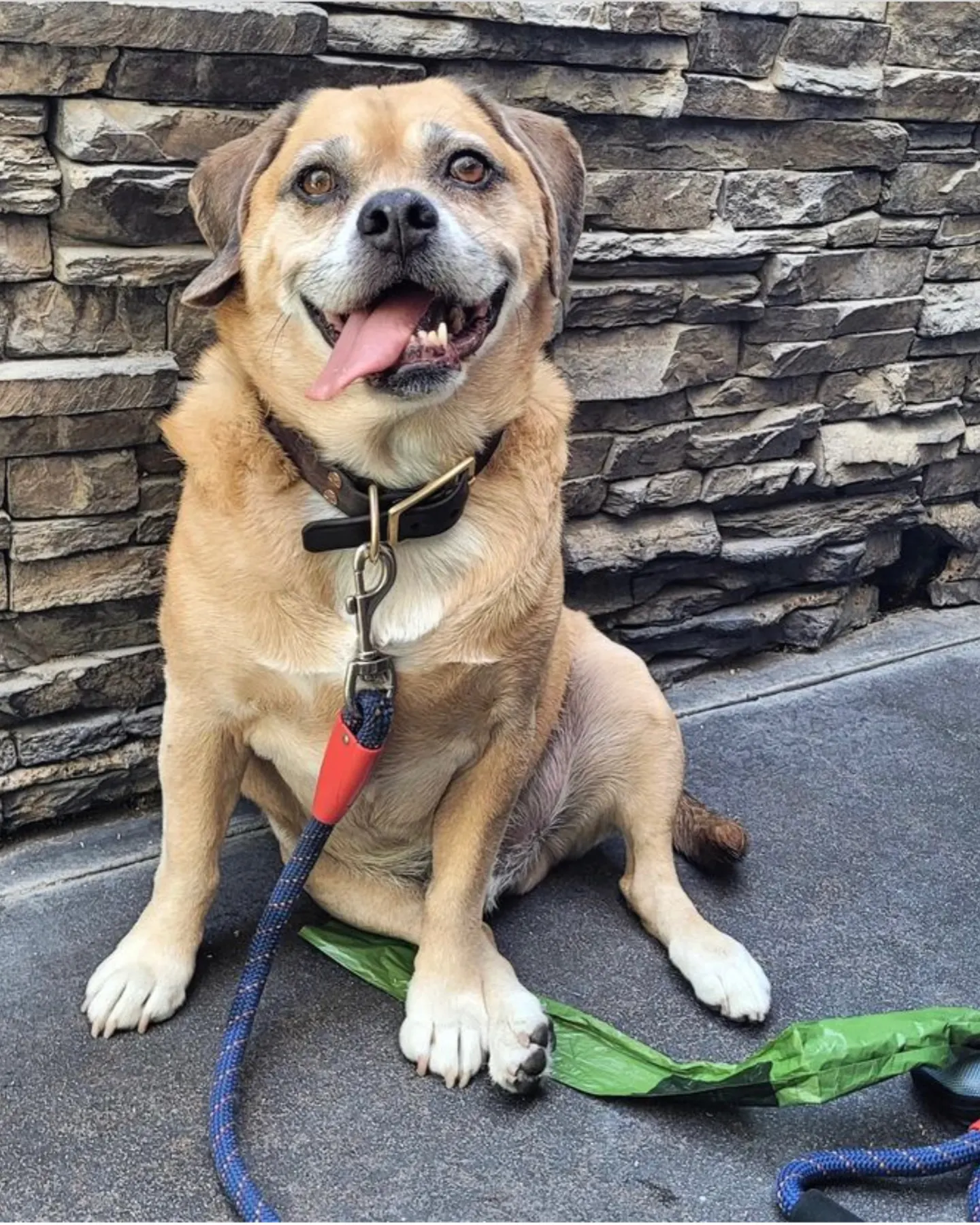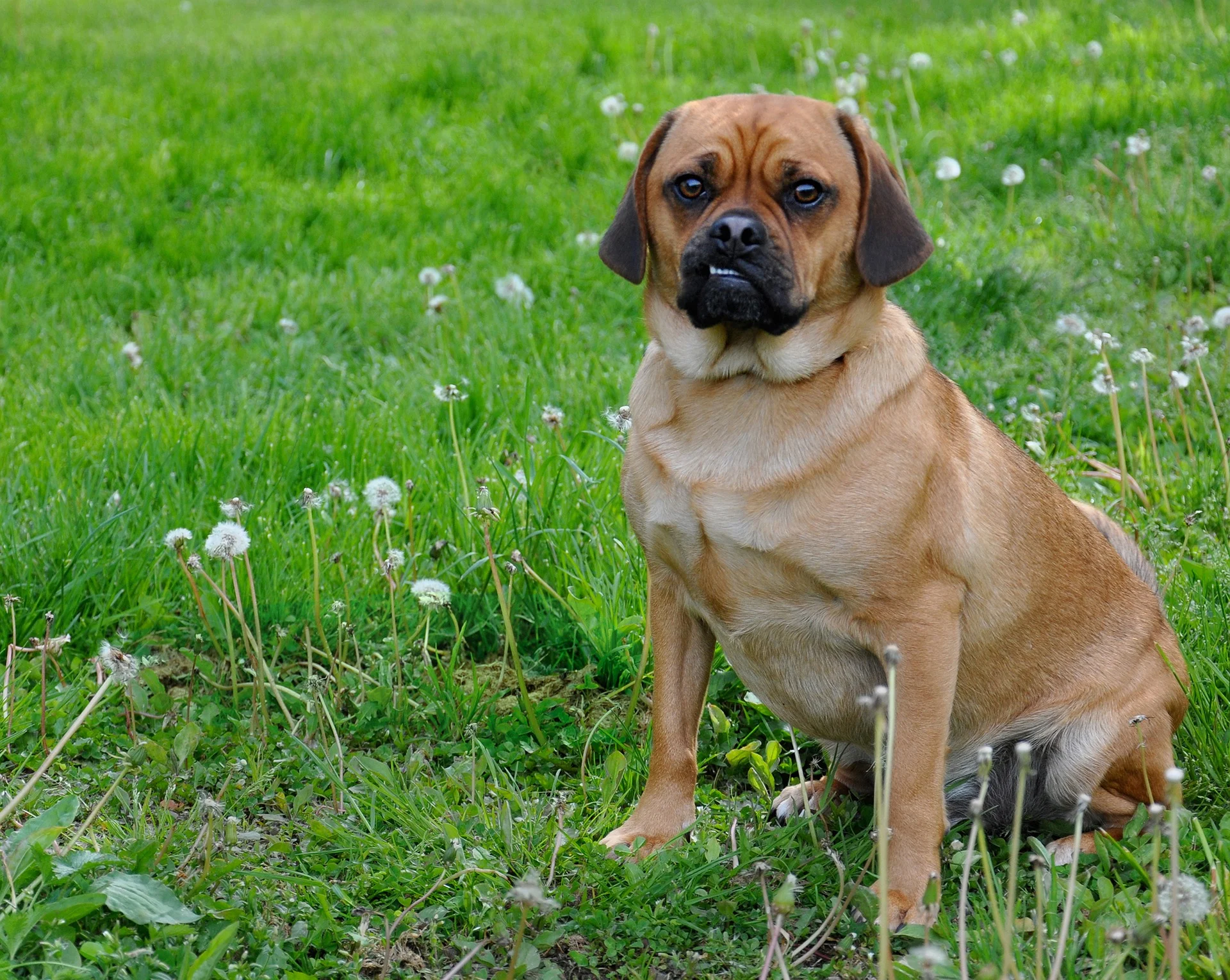The Puggle is an adorable but sassy combination of a Pug and a Beagle. They look like small Mastiffs because they have the wrinkles of their Pug parents and the longer snout, ears, and tail of their Beagle parents. Since the first Puggle was born in the 1990s, his popularity has grown quickly due to his unique look and friendly personality.
The Puggle is not a recognized breed, and there are no breed clubs or efforts to make him one. Most litters come from the first time Beagles and Pugs are bred together, but there have been a few times when Puggles have been bred with other Puggles, for a second-generation Puggle puppy.
People often call cross breeds like the Puggle “designer dogs” instead of “mixed breeds” because they are bred on purpose and are a mix of two known breeds. People who raise them hope to get the best of both breeds, like the laid-back personality of the Pug and the long nose of the Beagle, which makes it easier to breathe. But you can’t determine which of its parent’s features the puppy will inherit.
If you want to learn more about this unique and popular dog breed, keep on reading. However, we have to warn you again. Just like with any other mixed breed, you can’t ever know exactly what you are getting with a Puggle dog.
Background and History of Puggles
The Puggle is a cross between a Pug and a Beagle. It has traits from both breeds. In the 1980s, Puggle breeders in the United States wanted to combine the Pug’s friendly and loving nature with the Beagle’s longer nose, longer ears, and curious nature. One thing that makes hybrid breeds stand out is that they have very different personalities, looks, and ways of acting. Puggles are no different, and their owners have to rely on luck to get one.
A Puggle could get any of the good or bad traits from either of its parents. The most obvious sign of this is how they look. Puggles can have the fuller, rounder head of the Pug or the longer, leaner head of the Beagle. Their noses can be long or short, depending on what their original breeders wanted. The size of your Puggle can also be quite different. Most of the time, they weigh between 10 and 30 pounds and are between 10-15″ tall. Lastly, the Puggle’s coat can be any mix of colors from its parents, giving it a wide range of looks.
All signs point to the Puggle being one of the most popular mixed-breed dogs in the United States right now. Many people say that the Puggle is by far the most common and popular mixed-breed dog. Without AKC recognition, it’s hard to say how many Puggles there are, but it’s safe to say that they are very popular and can be seen all over the country. Many people think of the Puggle as the ideal hybrid or designer breed because celebrities often carry them around in public.

Source: Instagram (@dukythepuggle)
Personality of the Puggle puppy
The Puggle is an intelligent, friendly dog that fits well into most families. They can be funny and cuddly, and they like spending time with the people in their lives. Almost all Puggles are friendly with both people and other animals, and they love being the center of attention. The Puggle is a good choice for families who live in cities or apartments because of its small size and friendly personality.
They are playful and carefree, and they are always very happy. If your Puggle puppy has the same sense of smell as their hunting dog Beagle parent breed, which is common, they will often run after smells. Puggles are also known for being stubborn, which makes sense since both the Pug and the Beagle are stubborn. They are, as a whole, a smart and sensitive breed.
Don’t be surprised if your Puggle snores, even though their muzzles aren’t as short as the Pug’s. Puggles are known for the expressive sounds they make. They can howl, snort, and “talk” in other ways that go beyond simple barking. So if your neighbors mind a little bit of noise from time to time, rather go for another breed.
Caring for a Puggle
Puggles like to be around people, so they should live inside with their families instead of outside. As long as they stay inside and get enough exercise, they can live anywhere, even in apartments. But we have to warn you that they bark a lot. Some even like to howl, which is something they get from their Beagle parent.
Puggles are smart, but they can be hard to get along with. Training methods that use positive reinforcement, like giving them food rewards, letting them play, and giving them verbal praise, will work best with them. They won’t get out of hand if they have enough to do. Every day, take your Puggle for two 15-minute walks or playtimes. Make sure to always walk your Puggle on a leash or play with him in a safe area with a fence.
Exercise
The amount of exercise a Puggle needs will depend on whether it got its energy from the Pug or the Beagle. Pugs are generally low-energy dogs that are happy to just chill out. Beagles are much more active and like to play. As a general rule, you should take your Puggle on a moderate walk or an active play session every day. If your Puggle has a lot of energy, you will probably need to add a vigorous play session to your long walk.
People who live in cities and apartments can rejoice because this small dog is a great companion for almost any living situation. They don’t need much exercise, but they love playing with the family. Puggles love going on adventures in the great outdoors where they can smell everything. But they are a good size, don’t have too much energy, and are social enough that they will be fine living in the city as long as they get enough daily exercise.
The Beagle and Pug mix can be very sensitive to heat. Especially if they inherited the short muzzle of the Pug. So don’t take your Puggle out during the hottest parts of the day. And if they spend a lot of time outside, give them a cool, shady place to rest.
Training a Puggle
The Puggle is unique because it is both eager to please and stubborn. They love to entertain you and get lots of love, but they don’t like being told what to do. To train these puppies, you’ll need a gentle, treat-filled hand and a lot of time.
Training a Puggle can be hard, and the owner will need to be patient. Puggles should be socialized from a young age, which should be easy since they are a breed that naturally likes to be around people. As a Puggle owner, you should expect some stubbornness, especially when you first start to train your dog. If your Puggle got a natural curiosity and sense of smell of the Beagle, you can expect a dog with a shorter attention span that will often run off during training to follow a scent.
Positive reinforcement training is the best way to teach your Puggle how to listen to you and follow your instructions. Don’t give them tasks that are too similar, or they may get bored and move on to something else. And make sure to praise them a lot and give them snacks when they do what you ask. That’s why the most important command you can teach a Puggle is “come”.
Grooming
The Puggle is an easy-to-groom breed. Both the Pug and the Beagle have short hair, easy-care coats, so the Puggle does too. Brush them once or twice a week to keep their coat clean and healthy and to stop them from shedding. Most Puggles have a longer Beagle nose, so they are less likely to get infections in the folds of their face. When you groom your Puggle, it’s still a good idea to check this area. About once a month, you should give them a bath to keep their skin healthy.
To keep them healthy, all puppies need to have their ears, teeth, and nails checked. Extra dirt and wax should be cleaned out of the ears with a cotton swab, and teeth should be brushed once a week. This will help prevent dog dental problems. You should also cut your Beagle-Pug mix’s toenails every now and then so they don’t curl, crack, or get caught on rugs and clothes.
Feeding
How much your adult dog eats depends on his size, age, build, metabolism, and level of activity. Just like people, dogs are all different, so they don’t all need the same amount of food. It’s almost a given that a dog who likes to run around will need more than a dog who likes to sit around. The quality of the dog food you buy is also important. The better the dog food, the more nutrients will it deliver to your pup.
Buying commercial dog food is a great way to make sure your Puggle has a well-balanced diet. Look for food made for smaller breeds and stay away from ingredients that may be questionable or have too many grains. Whole foods like meat, healthy fats, and fruits and vegetables are great for dogs too.
Like their parents, Puggles like to eat and are often overweight. You should keep an eye on their weight to make sure it doesn’t get too high and become unhealthy. Lean proteins like fish and chicken will give these little explorers a lot of energy without making them feel heavy. Don’t just leave food out for your Puggle all the time. Instead, measure his food and feed him twice a day.
Health
The Puggle is a great example of how mixing purebred dogs can make a much healthier puppy. For instance, the shape of the Beagle’s muzzle gives a Puggle’s sinuses more space and keeps it from having the many breathing problems of a Pug. And the Beagle’s sometimes anxious nature is calmed by the Pug’s easygoing personality.
The Puggle has an average lifespan of 10 to 12 years, and even though most of them will live a long and healthy life, they are still prone to some health problems. That’s why it’s so important to buy from a reputable breeder who will make sure to do all of the important health screenings that this breed needs.
The most common health conditions in Puggles
Hip dysplasia
Hip dysplasia is an inherited condition in which the connection between the thigh bone and pelvis becomes loose. When the bones rub against each other, the cartilage that protects the bones starts to wear out in an uneven way. As the cartilage wears down unevenly, scar tissue and bone spur form. This makes it harder to move, causes painful arthritis, and can lead to lameness.
Stenotic Nares
Stenotic Nares, also called “pinched nose,” is a birth defect. Some signs are noisy breathing and not being able to handle exercise. Blue gums can be a sign that a dog isn’t getting enough oxygen. Mild cases can be treated by avoiding being overweight, not working out when it’s hot or humid, and using a harness instead of a neck collar. More severe cases may require surgical repair.

Source: Instagram (@dukythepuggle)
Patellar luxation
In this condition, the kneecap, or patella, moves away from its usual location. Your Puggle will suddenly lose the use of one of its front legs, refuse to put weight on a leg, shake one leg over and over, and look in pain and distress in extreme cases. Patellar luxation is a condition that mostly affects small breeds, with the risk being higher for miniature and teacup breeds.
Epilepsy
When a dog has epilepsy, he or she has repeated seizures. In general, seizures in dogs can be put into two groups: idiopathic seizures, which happen for no known reason, and symptomatic seizures, which are caused by an underlying medical condition. Most of the time, medication is used to treat idiopathic seizures to reduce or stop them from happening. The best way to treat symptomatic seizures is to treat the underlying medical problem that is causing them.
Cherry eye
This is an eye problem in which the dog’s third eyelid, or the eyelid that sits right next to the eyeball, sticks out and is visible. When this eyelid is exposed to dust and other particles, it quickly gets red and irritated. Cherry eye can be treated with medicine to reduce inflammation and put the eyelid back where it normally rests.
Hyperthyroidism
Hyperthyroidism is a condition in which the thyroid gland makes too many hormones. When a dog has hyperthyroidism, his or her metabolism speeds up. Hyperthyroidism is shown by vomiting, losing weight, drinking and urinating too much, having a bigger appetite, breathing and heart rates that are fast, and an enlarged thyroid gland. Hyperthyroidism in Puggles is usually a genetic condition that can be controlled with medications.
Conclusion
If you are looking for a companion dog that will fit in perfectly with your family life, the Puggle puppy might be the best choice for you. These designer dogs are known for being happy, sassy, and very affectionate.
Puggles are smart, but they may or may not want to do what you want them to do. Neither the Beagle nor the Pug is known for being easy to train, and both can be stubborn. Use positive reinforcement methods like food rewards, play, and praise, and keep training sessions short and sweet.
Another major concern with these family dogs is the fact that they could also inherit the short muzzle of their Pug parents and the respiratory problems that come with it. That means that your dog won’t be able to exercise for long periods of time or be in the heat for too long.
But if you are willing to deal with all of these factors, you will get an adorable pup, with a playful spirit, friendly nature, and adorable appearance. They do well in the company of other dogs, and kids love them as well!

